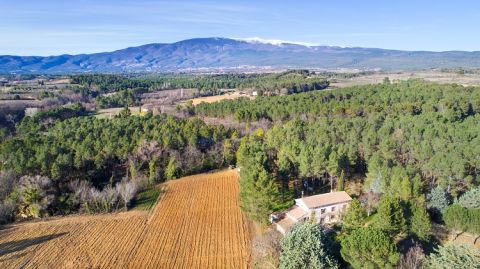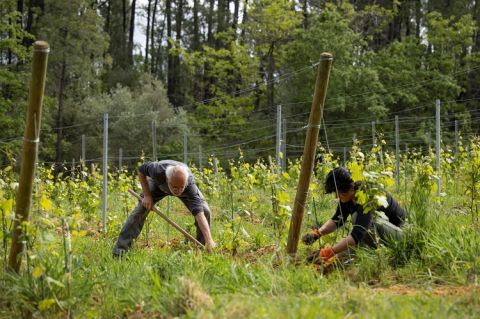Today, our wine competition entry is by an author who introduces herself thus: 'My name is Helena Olmi, 27 years old, born and raised in Lyon, France. With family roots in Corsica, my journey with wine started with tastings of Patrimonio wines and its local niellucciu grape. Particularly interested in viticulture, I first touch-based at Domaine Childeric while working as a vineyard hand for them for a few weeks as member of the WWOOF* program. Since then, I have come back a few times to give a hand during the 2019 harvest and 2020 spring works. I used to be working not too far in a winery in Châteauneuf-du-Pape, not in the vineyard but in sales. I am now back in my second home Montréal, Canada, experiencing freelance writing and working on a project of my own! You’ll probably find me scouting around Québec wineries in the next few months!' For other entries to the competition, see the guide.
Some places just knock you down. A remote location, vibrant energy, or the incredible human beings that crafted the place. Sometimes even it's the feeling of being just where you need to be. At Domaine Childeric, it's all of those things, all magically mingled together.
Passing through Mormoiron – a small town of eastern Vaucluse, a french region particularly known for being home to Châteauneuf-du-Pape and Gigondas – I am already overwhelmed with the smell of pine trees and the surreal saffron hue of the setting sun. In my back, the impressive Mont Ventoux, looming over me. Still a few minutes to drive until I can distinctly perceive Domaine Childeric's poetic road sign: an illustration of crushed wine grapes, in pastel colors. And a few words: ‘Domaine Childeric. Les rois fainéants. Gîte nature.’ (‘Domaine Childeric. The lazybones. Nature inn.’). A promise of tranquility, dizziness, drops of sweat, and subtle irony all the way.
Isabelle and Etienne Childeric decided to become winemakers at the age of 55, with a specific intention in mind: always have their ‘feet on the ground, hands in the vineyards, heads on their shoulders, in a sensitive and global approach to nature and the world’. Simple words, for a tremendous challenge and a daily discipline. Notions that, detailed separately, actually pick up most of what sustainability englobes. Yet, Etienne and Isabelle’s approach to sustainability is very humble. For them, the driving force of this project actually comes from a deeply anchored desire to create: to design, craft and sustain a winery just like an artist would with a piece of art. Yet, not a static and lifeless one. Instead, one that is alive and energized only because of its ties to people, to the living soil, to the earth, and beyond. One that brings back joy and that makes small things matter.
Here, sustainability is not an answer to a market demand, it’s just the way things are. While both Isabelle and Etienne have always been sensitive to nature and agriculture, viticulture and winemaking is new to both of them. They approach everything with new eyes, always very sincerely. Uncertainty is part of the game. And observation is essential. When looking for Etienne, most of the time I would find him kneeling in a vine row, staring at a leaf or two, questioning why a specific vine is less vigorous than its neighbor. Observation is his answer to a better understanding of nature. Observation is his path to tackle the challenges viticulture faces today.
Yet, their adventure as winemakers could not have been possible without the support of a strong and dedicated community. Domaine Childeric makes sense only through this community and its people. It has been financed collectively through a Groupement Foncier Agricole (GFA), an agricultural land grouping. The initial financing round in 2016 gathered forty-two individuals, mainly close friends and friends of friends. More than just a financing alternative, the GFA is the collective drive, manpower and energy behind Domaine Childeric. All key decisions are taken collectively. Members also contribute to the major works in the vineyard and in the cellar. Needless to say, the energy during the harvest is very special. Each one of them is profoundly attached to the place and to the project’s intention. But above all, to demonstrate that small-scale (the vineyard is approximately 4 hectares!), local and collective initiatives can have an impact.
In his thirst for knowledge and shared practice, Etienne (pictured above with his son Camille, photo by Arnaud Childeric – Studio Kalice) is also a member of a local work group that gathers winemakers and other growers of the region. Led by two biodynamic farming experts, the aim of the bi-monthly sessions is to go through Rudolf Steiner’s bible. More than just an obscure reading group trying to apply Steiner’s concepts methodically, the objective is to share practical observations and grow as a group. A great initiative that has shown Etienne the way through the Demeter certification, but mostly that biodynamic farming is a long and winding path that only makes sense when shared.
On a daily basis, Etienne and Isabelle work as a duo: there is no vineyard or cellar hand for now. From time to time, members of the agricultural exchange program WWOOF* are welcomed to give a hand. An incredible way of sharing skills, transmitting knowledge and spreading the word of the utmost importance of sustainable viticulture. Most of them stay in the renovated upper floor of the house that Isabelle runs as a bed & breakfast, to develop a second revenue stream.
You might be thinking at this point that such a small-scale local vineyard cannot sustain on the long run. Yet, Domaine Childeric pays scrupulous attention to business planning and project management. It has been clear from day one that the objective was to accompany this place in becoming a sustainable economic entity in the mid-term. Last year, 1.7 hectares of Grenache Blanc, Clairette, Vermentino and Cinsault were planted, with the intention of doubling the vineyard’s total production by 2023. With that in mind, a new cellar will be built in 2021. From 2021 onwards, Domaine Childeric will produce 15,000 bottles, with three red cuvées and two white cuvées. Not a bad achievement for two rois fainéants…
What particularly strikes me with Etienne and Isabelle is how much attention, care and intention they put into each decision. Heating? The house runs at 100% with its own hybrid solar panels (hot water and electricity), installed by Camille, Etienne and Isabelle’s son. Oak barrels? Thoroughly hand-picked by Etienne on the second-hand market. Build a 110 square meter cellar from scratch? Not only will it be the result of collective group work, it will be an energy-sufficient cellar made of a wooden frame, insulated with barley straw, lime and mud. A process that will ensure a cellar with thermal inertia, perfect insulation and controlled hygrometry. With gravity making the magic, no mechanical intervention. Logistics? Bundled-purchases led by members of the GFA in major french cities to facilitate bulk deliveries, directly to clients’ doorsteps. Communication? Isabelle and Etienne are leading, along with three other neighbour winemakers, the organization of micro-fairs to make Ventoux wines shine. The first stop will be in Marseille next February, along with ten other Ventoux winemakers carefully selected.
But why? Why bother? First, to stay true to the pure magic that happens when you open a bottle of Bras Dessus Bras Dessous… A vibrant, fresh, velvety wine that is a pure expression of their land and work. Sustainable winemaking begins with sustainable viticulture. A good wine essentially comes from good grapes, and good grapes essentially come from living soils. Of course, this means no chemical inputs, but also meticulous work to preserve balanced soils. All rows are covered with a mix of leguminous plants and grasses. Etienne is convinced that the expression of terroir in a wine can only happen when a winemaker reaches balance in his soil (soil biodiversity), and between his soil and the vines. And this fragile equilibrium can only be reached if you consider cover crops as your allies. Well maintained and pruned at the right moment, clovers will for instance be able to thrive, capture nitrogen in the air and return the excess in the soils; a vital process.
Second, Isabelle and Etienne are committed to preserving the surrounding 8 hectares of ochre land, dotted with pines, oaks, cypresses and olive trees – and working with them! They are actually part of a reflection group with researchers and a few other volunteer winemakers whose aim is to evaluate how agroforestry could be a response to climate change in the vineyards.
Isabelle and Etienne care for their land, their community and their clients. They never take the easy way out. They drive change to foster sustainable agriculture. And they craft wonderful, exciting and honest wines. Such growers should be encouraged and celebrated.


